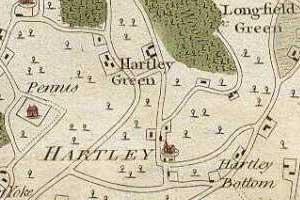Go To Section
Heytesbury
Double Member Borough
Available from Boydell and Brewer
Background Information
Right of Election:
in burgage holders
Number of voters:
26
Elections
| Date | Candidate | Votes |
|---|---|---|
| 16 Apr. 1754 | Pierce A'Court Ashe | 19 |
| William A'Court | 17 | |
| Thomas Bennet | 2 | |
| 25 Mar. 1761 | Pierce A'Court Ashe | |
| William A'Court | ||
| 16 Mar. 1768 | Charles Fitzroy Scudamore | |
| William A'Court | ||
| 8 Oct. 1774 | William A'Court Ashe (formerly A'Court) | |
| William Gordon | ||
| 5 Apr. 1775 | Gordon re-elected after appointment to office | |
| 9 Sept. 1780 | William A'Court Ashe | |
| William Eden | ||
| 4 Dec. 1780 | Francis Burton vice Eden, chose to sit for New Woodstock | |
| 3 Sept. 1781 | William Pierce Ashe A'Court vice William A'Court Ashe, deceased | |
| 31 Mar. 1784 | William Eden | |
| William Pierce Ashe A'Court |
Main Article
In the early part of the eighteenth century the family of Ashe owned a majority of the burgages at Heytesbury. On the death of Edward Ashe in 1748 the property was bequeathed first to his nephew William, and failing his line, to the heirs of Edward’s sister, Elizabeth, who had married Pierce A’Court. William died two years later without issue, and control of the borough passed to Pierce A’Court, the elder son of Elizabeth. He was then in possession of the great majority of the burgages, but his cousin Bridget Ashe retained three, the Duke of Marlborough had one, and there were four more held independently.1
Pierce A’Court and his brother William represented the borough in the next two Parliaments. Their election was opposed in 1754 and 1761 by Thomas Bennet of Norton Bavant, a village two miles from the borough. Although the votes cast for Bennet do not appear menacing, his activities gave the family considerable anxiety. On 5 June 1754 Pierce reported to William:2
Our neighbour endeavours still to ingratiate himself with the mob. Jack Bennet was over here Monday at our club feast and yesterday some part of ours was at Norton to compliment Squire Thomas.
In 1761 Bennet declined just before the poll commenced,3 but the A’Courts remained vigilant. On 2 May 1767 Pierce wrote to William:
All the borough houses not belonging to me are repairing and tenants promised already. We therefore should spare no time to consider what is to be done on our side. Delays are dangerous.
Such anxiety about what was, by contemporary standards, a very safe borough, might seem excessive, but it sprang from the dilemma of burgage borough management. If long leases were granted to tenants, there was ample opportunity for interlopers to suborn them. But if the leases were made out just before the election, they might be held invalid as occasional conveyances.
More substantial troubles next afflicted the family interest. In 1762 Pierce had married Janet Brown, with whom he had lived for several years, and had made a will, leaving the estates to her for life, and subsequently to his nephew, William. Janet became dissatisfied with this arrangement, demanding to know ‘what she was expected to live on?’4 During his last illness Pierce fell entirely under the domination of his wife, and was at length persuaded to make a codicil cutting out his nephew, and ordering the estates to be sold for the benefit of his widow. He died three months later, in September 1768.
William A’Court then began legal action to set aside the codicil, on the ground that it had been obtained by undue influence. He also objected that five of the leases were copyhold, and therefore inalienable. Janet retorted by selling the burgages to the Duke of Marlborough for £14,000,5 and actions followed to eject William A’Court’s supporters from possession.
In February 1772, ‘to put an end to the disputes and to accommodate all matters in difference’, the Duke and William A’Court agreed to suspend all legal actions and to divide the eighteen disputed properties between them.6 Each party was to nominate one of the representatives. Accordingly, at the election of 1774 the Duke nominated William Gordon and William A’Court took the other seat.
William A’Court, while keeping to the letter of the agreement, hoped to re-establish the family supremacy. In 1772 he held nine burgages, while the Duke held ten. By 1780 A’Court had acquired four more, three of them by purchase from his cousin Bridget. Just before the general election he took counsel’s opinion whether he could be compelled under the terms of the agreement to share these four burgages, and was assured that he could not. His brief included a description of the borough:7
Some of the burgage tenements are constantly inhabited but the greatest part of them are only inhabited for a short time previous to an election for the borough by persons in whom the General [A’Court] and the Duke confide, who are put into the burgage houses for the purpose of entitling them to vote as the inhabitants of such burgages.
After A’Court’s death in 1781 the family continued to buy up burgages as opportunity offered. In 1784 they owned fourteen, and by 1793 sixteen. But the compromise of 1772 was maintained throughout this period.
Author: J. A. Cannon
Notes
J.A. Cannon, ‘Borough of Heytesbury in the 18th Cent.’, Wilts. Arch. Natural Hist. Mag. lvii. 223-4.
- 1. ‘State of the borough in 1769’, mss of Lord Heytesbury.
- 2. Heytesbury mss.
- 3. Copy of poll, 1761, Heytesbury mss. The name Bennet is included, but no votes recorded for him.
- 4. Evidence on behalf of W. A’Court, Heytesbury mss.
- 5. Articles of Agreement, 3 Mar. 1769, Heytesbury mss.
- 6. Indenture, 27 Feb. 1772, Heytesbury mss.
- 7. Case, 29 Sept. 1780, Heytesbury mss.

